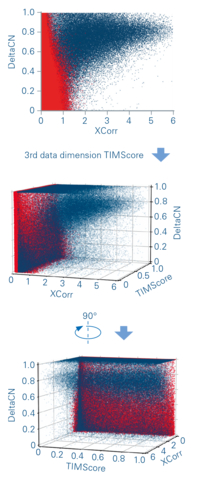CHARLESTON, S.C.– At US HUPO, Bruker Corporation (Nasdaq: BRKR) announced its TIMS DIA-NN software for the high-throughput, deep and unbiased 4D proteomics workflow. It now features the novel TIMScore algorithm which takes advantage of machine learning (ML) to predict CCS values of tryptic and phosphorylated peptides. With TIMScore, the measured CCS values are referenced against the predicted CCS values within the search space to call the most probable assignment, even when traditional search algorithms are unable to assign a peptide spectral match due to ambiguity resulting from low signal-to-noise or chimeric interferences. These features are now available in the GPU-based PaSER 2022 software release, building on the IP2 software assets acquired in 2021.
Dr. Dennis Trede, BioInformatics Program Manager at Bruker Daltonics, explained: “We developed a transformer model of peptide CCS from a ML training set of hundreds of thousands of tryptic and phosphorylated peptides, including double, triple and quadruple charge states. The model resulted in prediction accuracy of 95% for tryptic peptides and 92% for phosphorylated tryptic peptides, the most prevalent PTM with biological significance. We then worked with a published dataset (Ogata et al.) and could double the number of peptides identified from 42,930 to 98,949, and nearly 3.5x more than initially published. TIMScore libraries set the stage for dia-PASEF workflows to go even deeper into the proteome with more sequence and PTM coverage, all at scale and with throughput and outstanding sensitivity.”
Prof. Dr. Markus Ralser, Einstein Professor of Biochemistry at Charité, Berlin, Germany, and one of the co-inventors of DIA-NN, said: “Our ongoing collaboration with Bruker to tailor DIA-NN to a streamlined processing tool for dia-PASEF data with a CCS focus has been really rewarding. It simplifies and accelerates identifying and quantifying thousands of proteins in even very short gradients. We are pleased that within our close collaboration with Bruker, the vendor-integrated version, called TIMS DIA-NN, now becomes part of the PaSER bioinformatics platform.”
Dr. Robin Park, Proteomics Bioinformatics Architect at Bruker, added: “Since our DL training model also incorporated phosphopeptide data, TIMScore enhanced the identification of phosphorylated PSMs and peptides by an average of 61% on our dataset. Even more encouraging is the 57% improvement in the number of phosphopeptides identified using the strict 5% FLR cutoff. Site localization of PTMs can be difficult due to lability, stoichiometry, or its preferential dissociation, and as more training data becomes available, we will add more PTMs to our TIMScore algorithm.”
PaSER 2022 includes the TIMScore algorithm and TIMS DIA-NN for processing dia-PASEF workflows from timsTOF Pro 2, timsTOF SCP, and timsTOF fleX systems. PaSER utilizes the same data streaming mechanisms for dia-PASEF workflows in real-time MS, allowing for triggering of spectral library search at the end of the acquisition run, supporting ‘Run and Done’ for high-throughput 4D proteomics workflows.


